Asparagus: what is, care and reproduction

Imagine that the winter pattern on the windows has become a grassy green color - this is how an asparagus would look if carefully applied to the window: airy, lace, with needles. And the touch is the same - needle-like, but soft and fluffy. Once the plant was very popular in homes and workplaces, then disappeared from sight. And now, thanks to the emergence of new species and varieties, it is gaining popularity again, decorating our homes and offices.
What kind of flower it is, how to grow it and how to care for it, we will consider in this article.
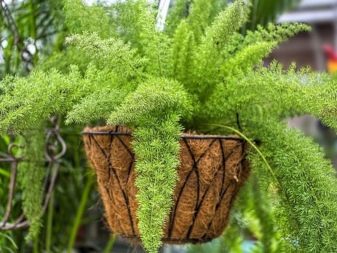

What it is?
According to various sources, there are from 200 to 300 species of asparagus (Asparagus) in the world, of which 27 species grow in the countries of the former USSR. If you carefully read the Latin name, you will understand that it looks like the word "asparagus". And it is not surprising, because this is another name for our home flower, which belongs to the asparagus family.
The stems of some domestic species do indeed resemble the tops of an edible tasty asparagus (whorled, medicinal, or short-leaved asparagus). A vegetable that tastes like chicken meat is a delicacy not only for vegetarians, but also for real gourmets of any cuisine.


The family of asparagus is represented by grasses, shrubs, shrubs, lianas, growing from North China to South Africa, including Europe and Asia. The Americas and Japan are also home to several plant species.
Vegetable culture was cultivated 4000 years ago in Ancient Egypt and Rome.

On a highly developed rhizome, thick shoots of 25 cm grow, which can be harvested only in the fourth year of the plant's growth, while they have a milky ripeness. The stems of asparagus are highly branched, on the branches there are a huge number of small needle-shaped branches (cladodia), collected in bunches, which sit in the axils of the leaves. But the leaves themselves in the usual sense are not - they are underdeveloped, small, similar to small thorns.
And even species that are very reminiscent of asparagus have not leaves, but pseudo-leaves, which are actually phylloclades - stem derivatives. The most striking example of a pseudo-leaf is Pontic Butcher (prickly).
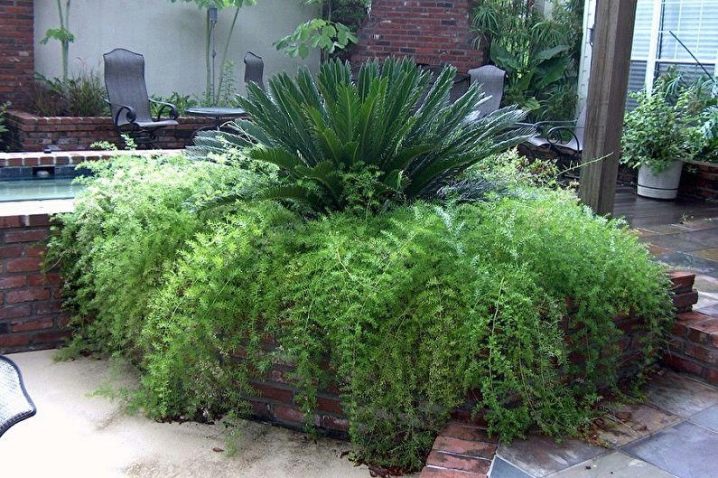
But unlike butcher's broom, the fruits and berries of domestic asparagus are inedible, and even poisonous. Berries are the result of a plant flowering. But flowers in indoor asparagus do not appear often, especially if the plants are not properly looked after. This is because flowers with stamens grow on some plants, and with pistils - on others. And if they are inaccessible from each other, then pollination does not occur, the fruits are not formed.
If the fruits did appear, then they look very beautiful on green stems: round, shiny and dense berries of red, orange or black color. Florists often use asparagus to decorate their bouquets. Compositions with painted plants look especially interesting.
To do this, use food dyes or special colors for flowers, which make the fluffy branches of asparagus silvery, golden, black and white - absolutely any, and unusually beautiful.


Views
All types of the asparagus family are divided into garden and indoor. Thanks to the large number of species and varieties, you can create not only cozy corners in the garden, but also at home.Asparagus look great as single plants in large and small areas, they can be used to create a living partition in a house or apartment. In addition, the plant is included in the top ten indoor flowers, able to ionize the air better than others, giving off oxygen. Therefore, we will get acquainted with the indoor views.
Asparagus
This flat-leafed species has several varieties that grow at home. In the open field, this is the same edible asparagus: a semi-shrub climbing perennial, the stems of which grow from 1.5 to 3 meters, with bunches of cladodia up to 3 centimeters in size. The plant has a pleasant light green color and a shiny surface.
Florists claim that indoor varieties of this species do not bloom, and there are no facts to confirm the opposite.
It's a pity: in nature, the plant blooms with pretty small white flowers, which are located along the entire length of the stems, it looks very delicate and unusual.

Meyer
This is a shrub 50 cm high, which can reach 6 meters in breadth. Differs in small cladodes - needles, which are very similar to a fox's tail. It is this second name that the plant has. The needles grow in different directions, and from this the branches become very fluffy. While they are not very tall, they stretch upward, resembling a forest of trees growing in the same pot. They look great in flower arrangements, for which they are appreciated by florists.

Cirrus (plumosus, bristle-like)
Evergreen perennial. The same flower that grew in many organizations of the Soviet period. It is a plant that grows strongly without pruning with graceful twigs. After flowering of snow-white miniature flowers, blue-black berries appear. By the way, plants that are more than 10 years old can bloom in the house. Thin needles of pale green color are very soft to the touch. It is probably about this species that they say that asparagus brings peace and relaxation to the house.
Lateral shoots are located almost in a horizontal plane, which is why the branches are very similar to a fern. Phylocladia are connected in small bundles of 10 pieces. Each filamentous shoot grows up to 5-15 mm.

Crescent
This is a liana (or a half-shrub), and the one who decided to purchase this flower should understand that it will take a lot of space. The plant has woody branches. Pseudo-leaves have small hook-like spines with which they cling, trying to get to sunlight. In this endeavor, they grow up to 4 meters. The plant has small flowers, collected in inflorescences, of a milky cream shade, with a pleasant smell. It got its name because of the appearance of the cladodes, which are quite long - 8 cm.
A characteristic feature of this species is its good tolerance to pruning.

Sprenger (dense-flowered, Ethiopian)
It was Karl Ludwig Sprenger who made asparagus popular in Europe as an ornamental plant. Creeping shoots of a half-shrub can reach 1.5 m, they have narrow-lanceolate cladodia of emerald color. These leaves are very small, scaly. After flowering with fragrant white or pale pink small flowers, oval burgundy berries are tied. The peculiarity of the plant is a powerful root system and a bare stem, which eventually turns into an arc.

Medeoloides
Cladodia vines do not look like needlelike, like plumosus, for example, but like ordinary leaves. An abundant amount of evergreen branches makes the plant very lush, so the question of how to grow it will definitely arise: substitute a trellis or place it under the ceiling on a shelf or cabinet.
There is little information about this species, but on any site you will find a mention that cut shoots can go without water for a long time, which attracts bouquets.

Pyramidal
This shrub may well replace the Christmas tree, because it has vertically growing shoots one and a half meters high with dense cladodia.The plant with its structure, shape and type of growth resembles a juniper, has dark green leaves directed upwards. It throws out long stalks with white, unassuming flowers. It can decorate not only an apartment, but also a winter garden or a balcony.

Setaceus
A popular species loved by flower growers and research biologists. Its dense multi-tiered green fluffy crown will adorn any interior. The plant loves light, regular feeding, relative warmth not lower than +10 degrees. If the setaceus turns yellow and begins to crumble, it means that the air in the room is too dry for it. You can achieve flowering in 5-6 years, observing all the care recommendations.

Racemose
Liana-shaped shrub with two-meter shoots. During flowering, pale pink flowers with a characteristic odor are collected in brushes, hence the name. The species is similar to Sprenger's asparagus, but the fruit is round, not oval, and its branches drooping, not creeping.
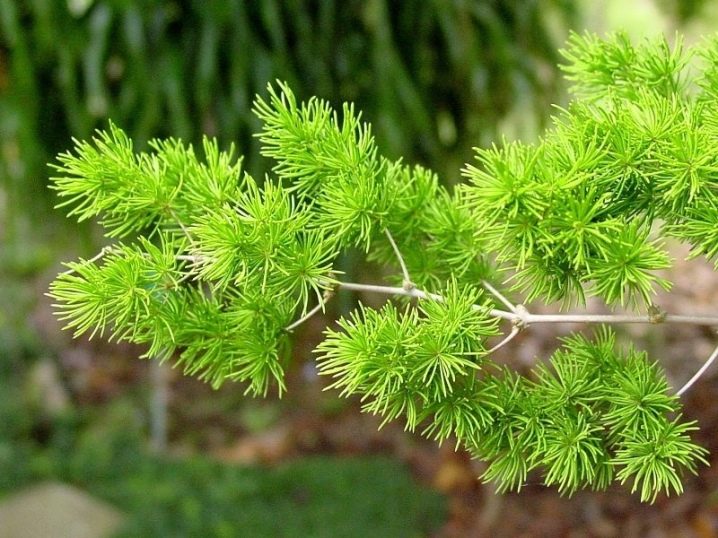
In addition to the fact that any type of asparagus supplies the room with oxygen, decorates it, it is believed that it also has a positive effect on the psycho-emotional background of the room:
- makes the atmosphere calm;
- has a positive effect on energy flows;
- neutralizes the negativity brought to the home or office;
- improves concentration of attention;
- increases mental performance.

Novice growers often cannot decide which plant to start with. Even experienced flower growers cannot choose, considering all plants worthy. In this case, the seeds mix, which the market abounds in, will help. Then several types of asparagus will grow in the house.
Landing
Before planting asparagus, you need to take care of a suitable soil and pot. As a soil, you can use:
- store-house universal earthen mixture for indoor flowers;
- fern substrate;
- a self-selected mixture of an equal amount of the following components: leaf earth, turf, peat, river sand, humus (compost);
- a substrate of humus, leafy earth, coarse sand (1: 1: 0.5);
- a mixture of turf, compost, leafy soil, river sand in a ratio of 2: 2: 2: 1.


Usually, before planting any plant, the earth is disinfected: it is spilled with boiling water or a weak manganese solution, the mixture is ignited on a baking sheet or frying pan, and steamed. Remember to cool the soil to room temperature before sowing.
Any container can be used as a pot, since it is still a temporary capacity until the seedlings are picked.


Planting instructions for asparagus are as follows.
- Sowing seeds is carried out from February to July. The optimal time is spring.
- Checking the quality of the seeds, they are calibrated: a teaspoon of salt is placed in a glass of warm water and the seeds are lowered. After a while, all the spoiled seeds will float up, while quality seeds will fall to the bottom.
- Immediately before sowing, the grain is dipped for a quarter of an hour in a weak solution of potassium permanganate.
- Since the seed coat is very hard, it is pierced with a disinfected needle to speed up the germination process. But this is optional.
- The prepared soil must be moist. Grains are spread on it in an even layer. They are slightly pressed and sprinkled with a thin layer of earth and sand. The top layer is moistened with a spray bottle.
- There should always be a 2-3 cm air gap between the top layer and the edge of the container.
- The container is covered with foil or glass. The container should be kept in a warm place, but not in direct sunlight.
- Due to the air gap, ventilation is not done, that is, the film is not removed until the emergence of shoots. Anyone who does not adhere to this rule and loves to ventilate the soil should not forget about regular spraying of the seeds.
- Seedlings should appear within 3-6 weeks. After pecking them, the film or glass is removed.
- When the "kids" reach 7-10 cm in height, they are dived, transplanted into separate temporary pots, each 8-10 cm in diameter.
- Saplings are grown on a warm windowsill under the light or under a lamp, remembering to constantly turn towards the sun for the even development of the plant.
- Asparagus is transplanted into a permanent pot with a diameter of 10-15 cm after 3-4 months with an obligatory drainage layer at the bottom of the pot.
Since any type of asparagus has a powerful root system, you need to attend to strong pots. Others may simply burst under the onslaught of rhizomes.



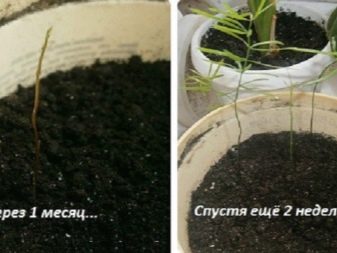
Care
Different plant families need special growing conditions, but this rule does not apply to asparagus - the cultivation of this plant is almost the same for all varieties.
A home flower will feel bad in direct sunlight, but it needs a lot of diffused light. You can determine that the plant does not have enough light by looking at the yellowing twigs. It is better to put the flower pot on the windowsill of the east or west room, or in the back of the room facing south. If the room is north, then you cannot do without additional lighting.
In the warm season, the flower will feel good on the street or balcony.

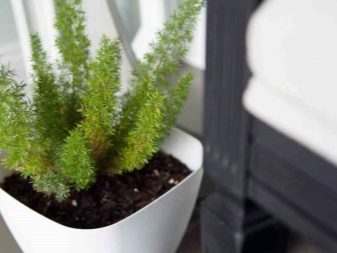
It may seem strange but it is much more difficult for asparagus to maintain the temperature regime in winter than in summer. And not because he needs heat, but, on the contrary, the optimal winter temperature is 10-14 degrees. Otherwise, the shoots will become thinner and stretched. In a cool environment, the plant will be dormant, slowing down its growth. During the active growing season, a suitable temperature is 18-22 degrees Celsius, preferably with ventilation. When taking a flower outside, you need to protect it from drafts. Better to put the asparagus in the shade.
To grow a healthy plant, it needs to be regularly sprayed and bathed at least once a month. A warm shower will not only save you from dust, but also wash away possible parasites and their egg-laying. In summer, the flower and the air next to it are sprayed twice a day. Often, a humidifier or just containers of water placed next to the flower are used to increase the humidity.


The frequency and amount of watering depends on the season, room temperature, flower size and type of pseudo-leaves. The soil in the pot should always be moistened, but half an hour after watering, there should be no standing water on the surface. In winter, asparagus is watered less often in any case, as it rests, growth is slowed down. If the room is cool, then the amount of water for irrigation is also reduced.
It is important to find the "golden mean" in watering as quickly as possible, otherwise a lack of moisture will lead to the discharge of greenery, and an excess will lead to decay of the roots.


As with all indoor plants, asparagus is fertilized from spring to mid-autumn twice a month with watering. It is wiser to use store-bought mineral dressings for decorative deciduous plantings. Using mullein or bird droppings, as advised on some sites, is useful for a flower, but not in an apartment. In addition, asparagus does not bloom all the time, which is why it does not need winter feeding.
You should also be aware that plants are not fertilized immediately after transplanting and during illness.


Trimming the crown to give it a beautiful shape, in a perennial, is quite specific and depends on the species. Asparagus crescent is considered the only indoor species that is loyal to cutting shoots. For all the rest, when the stem is cut, the lateral processes and cladodia cease to grow, a new bud begins to grow from the rhizome. That is, cutting off each old shoot will lead to the appearance of a new one from the rhizome. That's why the crown is formed not by trimming, but with the help of ladders, stands, pots, spirals and other devices.


Asparagus is a plant that is quite resistant to diseases and pests. If the flower receives excess moisture, then sooner or later its roots will begin to rot. This will lead to the appearance of such a fungal disease as root rot.It is especially likely to acquire it if watering is carried out at low temperatures or with cold water. This disease is treated by removing the decayed roots.
You need to follow a simple rule - do not be sorry and leave the diseased parts of the plant. This will only aggravate the situation. It is better to remove even slightly suspicious roots and shoots. For the procedure, the root system is completely washed, the earth is thrown away, and the pot is either scalded with potassium permanganate, or a new one is used.


Of the pests, spider mites and scale insects are the most common pests. If yellow-brown small oval spots appear on the pseudo-leaves, this is the scale insect. The spider mite enmeshes the plant with cobwebs, creating nests. The plant gradually turns yellow and dies off.
You can try to collect insects by hand, wipe the leaves with an alcohol napkin, rinse in the shower. But in the case of asparagus, this is ineffective, since there are no leaves as such. The most reliable way is insecticide treatment: "Fitoverm", "Vermitekom", "Aktara" and others.
Moreover, it is necessary to process not only the diseased plant, but also its neighbors.



Transfer
The perennial root system develops very quickly, so the plant is recommended to be transplanted annually, and when it turns 4, they begin to transplant every three years. The new flower pot should be large enough to fit the old one. The substrate is selected according to any of the above methods. The procedure is best done in early spring.
To transplant a flower it is watered abundantly and left for 2-3 hours to soak the earthen coma. Then they take it out of the container (they often turn the pot over for this), carefully examine the core of the flower. To rejuvenate the plant, old tubers are cut off, the root system can be halved. To the bottom of a new pot be sure to fill in a drainage layer, then soil, after which the roots are carefully laid out on the ground and covered with soil.
The plant does not need to be planted too deep, but there must be a place for watering on top, which should be done.

Reproduction
Indoor asparagus can be propagated by seeds (as described in detail above), cuttings and dividing the bush. Not every species is suitable for all three breeding methods. Sprenger's and Meyer's asparagus, as well as pinnate, reproduce well with seeds. Adult plants are suitable for division, which can painlessly restore the root system. When choosing a propagation method by cuttings, there is a great risk that not all seedlings will take root.
The easiest way to propagate asparagus is by division. It is recommended to do this at the time of transplantation. The main thing is to carefully separate the bunches of the plant along with the rhizome, cleanse of the old earth and visually make sure that the roots are healthy. The bush is planted in prepared moist soil. It is recommended to keep the flower cool for the first time, watering it regularly.
A month later, the "newcomer" is transferred to a permanent place.


Cutting is considered the most difficult not only because of the poor survival rate of plants, but also because of the procedure itself.
- It is important to choose the right branch for cutting - it must be strong last year's shoots. But a too short stump should not remain on the flower, otherwise it will not grow.
- Using a sharp alcoholized knife, cut 15 cm cuttings, leaving 4-5 cladodes on each. It is not recommended to cut with scissors, as they crush the stem.
- Cuttings are planted in a mixture of peat, perlite and sand, poured into a transparent glass. The glass should not be too large - this is a waste of soil, and it will be inconvenient to watch the appearance of roots.
- The cups are placed in a warm, well-lit place and covered with a plastic or glass cap.
- Every day, the seedlings are ventilated and slightly moistened. It is advisable that the condensation drops do not touch the greenery.
- After a month, the roots should be visible in the glass.If the size of the cup allows, then let the stalk grow in it for a couple of weeks.
After 2 weeks, the cutting is transplanted into a permanent pot.



For tips on transplanting asparagus, see the following video.



























The comment was sent successfully.